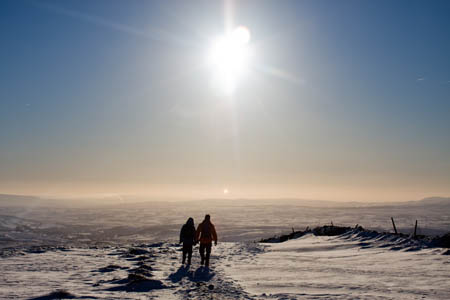
Winter walking is great. But keep safe
As much of Britain is cloaked in the white stuff, and walkers’ and mountain lovers’ hopes of a decent winter rise, it’s important to revise our approach to tackling the hills as snow and ice cover our usual routes and temperatures drop below freezing.
Scotland had a great winter last year, with prolonged snow cover over much of the Highlands, but much of England and Wales missed out on true winter conditions.
However, early snowfalls have brought a true flavour of arctic walking to many areas this week. Here’s our survival guide to walking in winter.
Keep it shorter. Daylight hours are severely curtailed as we approach the winter solstice. The further north you are, the earlier you’ll see the back of the sun, but even in England, the sun will dip behind the hills well before 4pm at this time of year.
Langdale and Ambleside Mountain Rescue Team’s website has a graph showing sunset times throughout the year – but bear in mind that relates to the Lake District. Scotland’s sunset times will be earlier in winter and later in summer. There is also a slight difference in west-to-east times. But in short, you can expect darkness to start falling around 3.30 to 4pm in December, which means either making an earlier start or reining in the distance you walk.
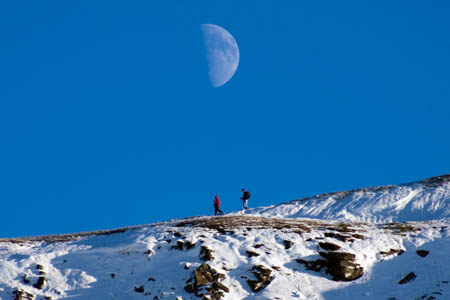
Days are shorter and it's easy to run out of light in winter
In any case, make sure you pack a headtorch in your rucksack in case you get caught out. One of the prime reasons mountain rescuers are called out is because inexperienced walkers get benighted without a torch. All sorts of things can happen which might delay a return to the valley on time. You really don’t want to be forced into an unscheduled stay on the fell tops in sub-zero temperatures for the want of packing some illumination.
Another reason for shortening routes in winter is the effort required for walking in ice and snow conditions.
Hillwalking can be much more strenuous when every footstep is breaking a new trail, when the crust on snow collapses each time you step on it and your leg plunges deep into the pack. There will be more muscular effort required staying vertical on hard-frozen snow and ice and the mere feat of staying warm
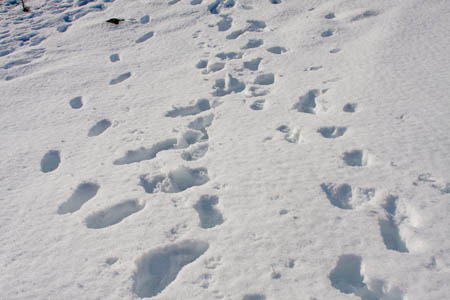
Don't be afraid to follow in another walker's footsteps, but check they were going your way
on a cold mountain or hill requires extra energy. Don’t scrimp on food, either before or during your trip.
And don’t be afraid to use a trail that has already been broken – it’s not cheating! Obviously, the direction of the footsteps you use has to be right: make sure they are going where you want to be, but it’s a lot less effort using a set of steps and compacted holes in the snow made by a previous walker than ploughing your own.
If you are in a group and are breaking a new trail across virgin snow – which can be an exhilarating prospect – take it in turns to be the trailbreaker. And be very careful with your navigation. Even hills which are familiar to you will look very different in snow. Paths disappear completely and hazardous terrain can be blanketed by an even covering of snow. Contour lines and the ability to relate the map to the ground become essential when walking in these conditions. When all other features have disappeared, the slopes and topographic features outlined by those little wiggly brown lines will still be there and it is important to be able to identify them.
Winter walking will normally be at a slower pace, which is another reason to be wary of too long a route. If you walk at 5km an hour in good conditions, expect this to drop to something like 3km an hour on snow and ice.
It’s best to try to pace yourself throughout the day. Frequent stops are bad news in bad conditions: the body rapidly cools down and sluggishness can creep in. Aim to finish the day at the same pace as you started. Don’t go dashing up the hill to play in the snow like a three-year-old (unless you are a three-year-old!); keep your pace manageable.
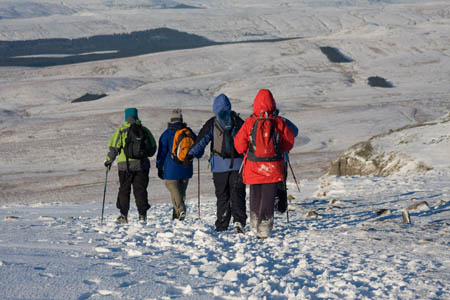
Keep to communal breaks if walking in a group
If you’re walking in a group, have a short break every now and again when everyone can do the adjustments they need to: put on or take off layers; have a chocolate bar; take the group picture and such like. That way, the group isn’t slowed unnecessarily by individual members frequently holding everyone up by breaking the pace. A Mountain Instructor we know calls this the ‘communal faff’ and it’s a sound idea when the temperature is low and conditions poor.
While on the subject of breaks, there is the delicate question of toilet stops. Take the opportunity of the communal faff to do what nature dictates. Women may wish to invest in one of the devices which enables them to pee standing up, such as the Sheewee or Whiz. That way, they don’t have to risk frostbite on some very tender regions by exposing the whole of their nether regions.
The same regard for the environment should also be applied on the hills even when the ground is frozen or covered in snow and ice. Toilet stops should be well away from streams and other water courses. If you really do need to defecate on the hills, it’s unlikely you’re going to be able to bury it. So you really will need to consider bagging it and carrying it out. Otherwise, when the snows melt, fellow walkers will be faced with highly objectionable reminders of your visit. CairnGorm Mountain even installed a poo-chute and supplies special containers for the stuff, in the face of so many winter mountaineers causing a real environmental hazard with their bodily waste.
Make sure you have plenty of water. Extra cold means extra clothing and you are going to sweat when you are ascending the fells. Dehydration can heighten the likelihood of hypothermia, so it’s important to keep up the fluid intake. If you use a hydration bladder and tube, blow the fluid back into the bladder after you’ve had your drink. It will lessen the chance of your tube freezing up.
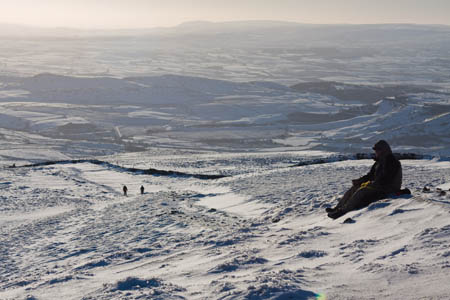
Consider where to stop for lunch: is the summit the ideal place?
Keep breaks for food short too. Within a few minutes of stopping, your core temperature will start to fall, especially if you have put some effort into getting to the top of the mountain and have been sweating. It’s customary to see groups of walkers eating their lunch at the summit. Consider whether this is the best place to eat. Maybe there’s a little sheltered spot nearby which affords just as good a view but less exposure. Consider the wind direction: hollows in the ground can be surprisingly warmer; sit on the right side of a wall and you’ll feel five or six degrees’ benefit. And if the sun’s out, use it. It can be surprisingly warm, even in mid-winter.
Of course, if you’re in a whiteout or blizzard, it makes no sense at all to sit and eat on the summit. Get yourself down a few hundred metres to where the weather may be less severe. And keep that break to a minimum. Little and often is the mantra for food on mountain expeditions; in winter even more so.
Consider carefully your clothing and especially footwear before you make your trip. That extra layer could be a lifesaver. Imagine the worst possible conditions you might encounter and pack for that. It may be cold in the valley, but think of the wind-chill 600m higher. Good base layers, which wick the sweat away from your body, are important. Mid layers will be a personal choice and a good waterproof essential. If you really do envisage spending a lot of time inactive on the fell, a duvet jacket might be wise.
A hat and gloves are absolutes. Anything up to 60 per cent of your body’s heat loss will be through your head. [Update: see Hats, heads, and heat: medics debunk decades-old myth - Editor] Hoods, though capable of keeping you dry, won’t keep in much heat. You will need to think up a step for winter gloves too. Those thin ones that are all right for a cool day in autumn will probably give little benefit when the wind-chill factor takes the felltop temperature down to -12C. Our Mountain Instructor friend rates Scottish mountain days by the number of pairs of gloves he needs: ‘Today’s a three-pairs-of-gloves day’. They will get wet: snow is, after all, just water in disguise and you will be putting your hands into the stuff even if it’s only to steady yourself on steeper ground.
Consider what you may need if things go wrong. A plastic bivvy bag is almost the least to take. An emergency group shelter is pretty much essential if there is a group of you and can be used to eat your lunch in if you can’t find shelter. Map and compass will hopefully stop you going astray in an unfamiliar environment and a GPS unit as backup could well get you out of a spot. But be aware that battery performance drops with temperature: don’t rely solely on anything electronic. They hate the cold and may fail after a few hours on the tops in winter. The same goes for mobile phones.
All of this means one thing: a heavier rucksack than your winter kit. Another reason why you may start flagging if your route is too long.
Route choice is important too. Do you really want to be on Striding Edge when it is covered in verglas and there’s an 80mph wind? Consider carefully your limitations and those of your party members.
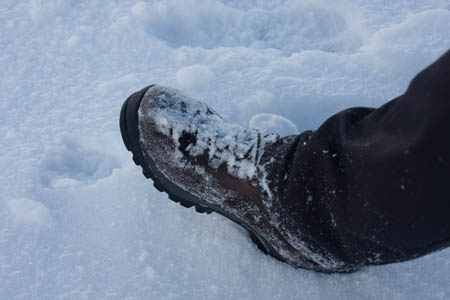
Stiff-soled boots allow kicking the heel into snow on descent
Scottish ridges in winter are a very different prospect to summer excursions and you will be stepping into the realm of true winter mountaineering on routes such as Aonach Eagach.
Consider too, if there’s any prospect of the sun being out, sunglasses or even goggles. It’s no joke being struck by snow blindness and the effects are painful. 90 per cent of ultra-violet light will be reflected back by snow and you probably won’t feel the full effects until eight to 12 hours after the damage has been done. Even on dull days, the amount of UV light hitting your eyes can be enough to trigger mild snow blindness.
Footwear becomes even more crucial in winter conditions. If you’re going to face hard snow and ice, stiff boots come into their own. You can kick steps into steeper ground, ‘edge’ with them, and dig the heels into the snow when descending. They make a trip on to the fells in winter a safer prospect.
That said, we have seen people on the hills in fellrunning shoes in winter. If the snow is soft enough for their rubber studs to bite into, they can give a good amount of grip. Trouble is, you won’t know what the conditions are like on the tops until you’re up there.
Gaiters can stop powdery and loose snow filling boots. Socks containing merino wool will probably keep feet warmer in cold, wet conditions.
For true winter mountaineering conditions, as you will find on Scottish mountains and the higher hills of England and Wales, full winter kit is required: stiff boots and crampons and an ice axe. These look like the stuff Everest summiteers need, but they are essential for mountain walkers in winter too.
But more essential than having crampons and ice axes is the knowledge and ability to use them. Buying the right item is just the starting point. You will need instruction and practice before you can safely put them to use in real situations. Essentially, this means going on a course that will teach you not just how to self-arrest with your ice axe – one of the key uses for mountain walkers – but also how to move safely in winter conditions, evaluate avalanche risk and all the other essentials for keeping it safe in Britain’s wintry mountain wonderland.
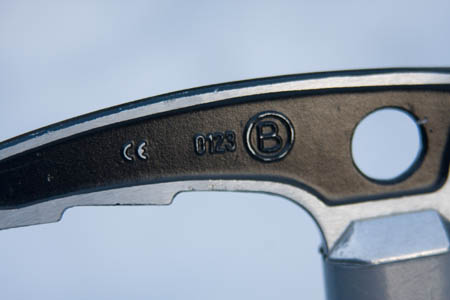
The 'B' on this ice-axe head denotes it is a basic one, suitable for mountain walking but not technical climbing
If you’re going to take that step, you will need to equip yourself with appropriate gear. Ice axes come in two grades: basic and technical. Unless you’re a climber about to tackle serious steep routes, stick to a basic axe. It will be marked with a ‘B’ and means it has been made with the mountain walker in mind, rather than ice climbing.
Similarly with boots: all boots should have a crampon rating. A B0 boot will not take any crampon, other than very basic strap-on devices which are not really meant for serious hillwalking. Boots that will take crampons are rated B1, B2 and B3. As the numbers rise, so does the stiffness of the boot, so B3s are rigid mountain boots, often plastic, that really are not general use boots and are restricted to winter mountain use, often on serious, steep routes and climbs.
B2s are semi flexible and B1s more flexible still. The simple rule is: don’t fit a crampon to a boot that is rated more flexible than the crampon, or it might fall off just when you need it most.
To help, crampons are also rated C1, C2 and C3, with C1s flexible, C2s semi-flexible and C3s rigid.
C1s will allow mountain walking in most situations and often have 10 points. C2s tend to have more points, eg 12, and will allow a move on to steeper, moderate routes and easier climbs. C3s are meant for serious climbing.
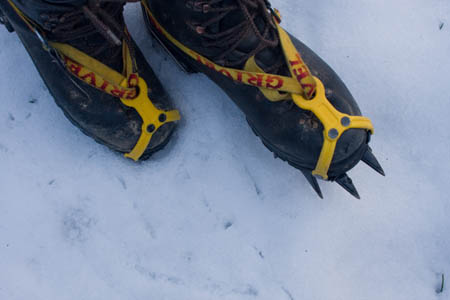
B2 crampons on B2 boots: never use a crampon with a higher rating than the boot
Just to complicate matters, various types of bindings are used, such as step-in or strap on. Make sure the shop you go to understands compatibility and all the other issues with winter gear.
If you think you might fancy learning how to use ice-axe and crampon, you can hire the gear from many shops in the Highlands on a daily basis. But instruction in their use is essential.
And be prepared to come back with shredded gaiters: those spikes can be quite sharp.
A winter skills course will also teach you the difference between types of snow, from graupel to névé. If you thought snow was snow, think again. There are numerous types, including spatial dendrites, stellar crystals and plates. And then there is hoar frost and rime.
This gives a hint of the appeal of walking the hills in winter. We’ve dwelled on the hazards, but the rewards are legion. It really is another world up there. Visually, on a cold clear day following snowfall, the uplands take on a completely different aspect. It’s a joy to be in a truly arctic type of environment, especially as it can be virtually on your doorstep.
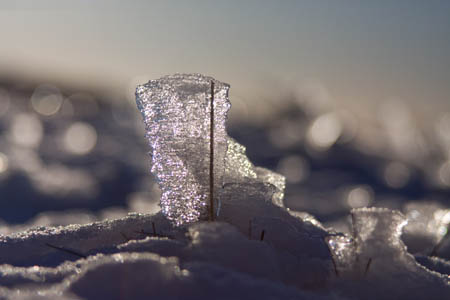
A broad flag of rime on a blade of summit grass
A well planned, well equipped winter expedition on to Britain’s mountains will provide you with memories for years to come. We don’t always get the winters we could once expect, so make the most of the snow-cloaked hills. Just don’t end up a mountain rescue statistic.
One final thing to consider: the roads. It is not always easy actually getting to the starting point for a winter walk. If you can set off in your boots from your doorstep, count yourself lucky. Otherwise, you’ll need a bit of winter motoring savvy to access your walk. High roads could be blocked by snow and even those in the valley could be treacherous. That layby that could hold half a dozen cars could now be piled high with cleared snow.
Early morning drives may precede the gritters, so you will need extra caution on untreated roads. Consider the trains, if you can use them. They tend to be less affected by adverse weather than some road transport.
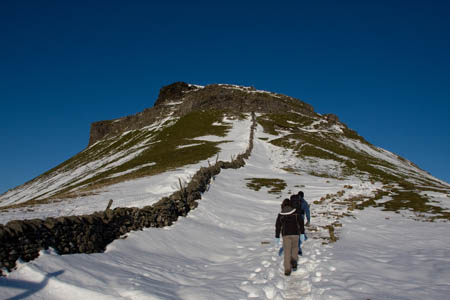
The hills are there to be enjoyed this winter - but do it safely
So choose a route that you can get to without a perilous road journey. Particularly in Scotland, a lower, coastal route may be passable while the inland pass may be closed. Use the radio, Internet and other media to get up-to-date reports.
And never go out without getting a weather forecast. Use grough’s links tab at the top of the page to access all the weather information you will need. The Scottish Avalanche Information Service will be carrying full reports from 16 December for Lochaber and the northern Cairngorms, with the three other areas covered by the service starting on 22 December.
So the key to a successful winter hillwalk is, as the Scouts would say: be prepared. Plan well, don’t overstretch yourself, particularly if you are inexperienced, equip and clothe yourself appropriately, and make sure you leave a note of your route with someone.
Now get out there and enjoy it while it lasts.
- Have you any tips for winter safety on the hills? Share them with grough readers in the comments box below
Philip Werner
16 December 2008Fantastic article. I'm about to take the plunge into mountaineering and this is a great summary of gear/skills/and advice. Thx!
richard simmons
16 December 2008very well written article, everything you need to know
Richard Warren
22 December 2008Good article grough - I will ink it onto the teams mountain rescue website and also send it off to Where-wolf.com who have some strong MRT links - I have attached a link to the WMRT website which has some top tips including a link to ice axe breaking, but as grough say - you really need to get someone to teach you (walking ploes will not stop you in a slide and will infact just get in the way once youstart accelarating)
http://www.wasdale-mountain-rescue.org.uk/top_tips.htm
Kind regards and a happy Xmas to all at grough
Richard Warren
Chairman LDSAMRa plus Wasdale MRT
Homepage
03 July 2013... [Trackback]...
[...] There you will find 66267 more Infos: grough.co.uk/magazine/2008/12/07/the-white-stuff-how-winter-hillwalkers-can-stay-safe/trackback? [...]...